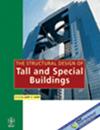Dynamic analysis and optimization of a wind turbine tower subject to wind and earthquake loads
IF 1.3
3区 工程技术
Q3 CONSTRUCTION & BUILDING TECHNOLOGY
引用次数: 0
Abstract
A dynamic model of a wind turbine tower is established to investigate its dynamic responses under wind and earthquake loads. Then a generalized global spatial discretization method is used to solve the problem. Modal analysis of the wind turbine tower is conducted using the dynamic model and the results are verified by shell models and beam models established in the commercial FE software ANSYS and LS‐DYNA. Transient vibration displacements, as well as normal and shear stress distributions of the wind turbine tower subject to different levels of pulsing wind loads, are calculated based on the dynamic model. Quasi‐static motion and transient motion assumptions are applied to evaluate the strengths of the tower, respectively. Influences of different earthquake ground motions on vibration amplitudes of the tower top are examined. Then, a hybrid mutation particle swarm optimization algorithm is used to perform design optimization on the tower body thickness for vibration reduction with its weights and strength being constrained. The penalty function strategy is used to deal with the constraints on body weight and stress level. Results demonstrate that the comprehensive performances of the wind turbine tower especially the tower top vibration have been greatly reduced after optimization.风力发电机组塔架在风和地震作用下的动力分析与优化
建立了风力发电塔架的动力模型,研究了塔架在风荷载和地震作用下的动力响应。然后采用广义全局空间离散化方法求解该问题。利用该动力模型对风力机塔架进行了模态分析,并利用商用有限元软件ANSYS和LS‐DYNA建立的壳体模型和梁模型对分析结果进行了验证。基于该动力学模型,计算了风力机塔架在不同脉动风荷载作用下的瞬态振动位移以及法向应力和剪应力分布。分别采用准静态运动和瞬态运动假设来评估塔的强度。研究了不同地震动对塔顶振动幅值的影响。然后,采用混合突变粒子群优化算法,在约束塔体重量和强度的情况下,对塔体厚度进行减振设计优化。采用罚函数策略来处理体重和应力水平的约束。结果表明,优化后的风力机塔架的综合性能,特别是塔顶振动得到了较大的降低。
本文章由计算机程序翻译,如有差异,请以英文原文为准。
求助全文
约1分钟内获得全文
求助全文
来源期刊
CiteScore
5.30
自引率
4.20%
发文量
83
审稿时长
6-12 weeks
期刊介绍:
The Structural Design of Tall and Special Buildings provides structural engineers and contractors with a detailed written presentation of innovative structural engineering and construction practices for tall and special buildings. It also presents applied research on new materials or analysis methods that can directly benefit structural engineers involved in the design of tall and special buildings. The editor''s policy is to maintain a reasonable balance between papers from design engineers and from research workers so that the Journal will be useful to both groups. The problems in this field and their solutions are international in character and require a knowledge of several traditional disciplines and the Journal will reflect this.
The main subject of the Journal is the structural design and construction of tall and special buildings. The basic definition of a tall building, in the context of the Journal audience, is a structure that is equal to or greater than 50 meters (165 feet) in height, or 14 stories or greater. A special building is one with unique architectural or structural characteristics.
However, manuscripts dealing with chimneys, water towers, silos, cooling towers, and pools will generally not be considered for review. The journal will present papers on new innovative structural systems, materials and methods of analysis.

 求助内容:
求助内容: 应助结果提醒方式:
应助结果提醒方式:


